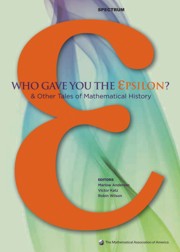Book contents
- Frontmatter
- Introduction
- Contents
- Analysis
- Geometry, Topology and Foundations
- Foreword
- Gauss and the Non-Euclidean Geometry
- History of the Parallel Postulate
- The Rise and Fall of Projective Geometry
- Notes on the History of Geometrical Ideas
- A note on the history of the Cantor set and Cantor function
- Evolution of the Topological Concept of “Connected”
- A Brief, Subjective History of Homology and Homotopy Theory in this Century
- The Origins of Modern Axiomatics: Pasch to Peano
- C. S. Peirce's Philosophy of Infinite Sets
- On the Development of Logics between the two World Wars
- Dedekind's Theorem:√2 × √3 = √6
- Afterword
- Algebra and Number Theory
- Surveys
- Index
- About the Editors
C. S. Peirce's Philosophy of Infinite Sets
from Geometry, Topology and Foundations
- Frontmatter
- Introduction
- Contents
- Analysis
- Geometry, Topology and Foundations
- Foreword
- Gauss and the Non-Euclidean Geometry
- History of the Parallel Postulate
- The Rise and Fall of Projective Geometry
- Notes on the History of Geometrical Ideas
- A note on the history of the Cantor set and Cantor function
- Evolution of the Topological Concept of “Connected”
- A Brief, Subjective History of Homology and Homotopy Theory in this Century
- The Origins of Modern Axiomatics: Pasch to Peano
- C. S. Peirce's Philosophy of Infinite Sets
- On the Development of Logics between the two World Wars
- Dedekind's Theorem:√2 × √3 = √6
- Afterword
- Algebra and Number Theory
- Surveys
- Index
- About the Editors
Summary
I fear I might seem to talk gibberish to you, so different is your state of mental training and mine ([31], p. 109).
Charles Sanders PeirceAmerican mathematics, like American science generally in the nineteenth century, remained underdeveloped, depended heavily upon European models, and made few independent and recognized contributions of its own. Though presidents like Jefferson might take a pedagogical interest in mathematics and its teaching, and while Garfield, in fact, discovered an interesting variation on the many proofs of the Pythagorean theorem, American mathematics generally remained without support, either institutional or financial, until late in the century (see [28] and [37]).
Despite the lack of incentives to pursue a mathematical career in America, there were nevertheless some who made important contributions to mathematics in the United States. One of the most interesting of these, Charles Sanders Peirce, made fundamental discoveries, largely independent of his European counterparts, in set theory and mathematical logic. This paper explores the nature and significance of Peirce's contributions.
Though his study of continuity led him to produce results paralleling in some ways the contributions of Georg Cantor and Richard Dedekind in Germany, Peirce's work was dramatically different in its origins, inspiration, and ultimate mathematical character. In order to understand the fate of Peirce and his mathematical studies of continuity and infinity, it is necessary first to say something about the status of American science in general, and of American mathematics in particular, in the nineteenth century.
- Type
- Chapter
- Information
- Who Gave You the Epsilon?And Other Tales of Mathematical History, pp. 161 - 171Publisher: Mathematical Association of AmericaPrint publication year: 2009



